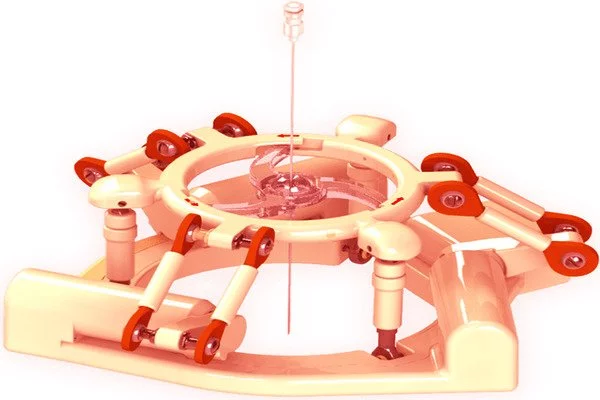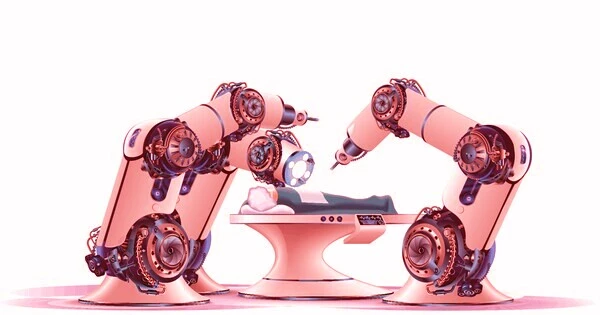Percutaneous nephrolithotomy (PCNL) is an effective, minimally invasive gold standard procedure for removing large kidney stones. Creating access from the skin on the back to the kidney, known as renal access, is a critical but difficult step in PCNL. Inadequately created renal access can result in severe complications such as massive bleeding, thoracis, and bowel injuries, renal pelvis perforation, or even sepsis. As a result, it is not surprising that performing this procedure efficiently requires years of training and practice. During PCNL, there are two main renal access methods used: fluoroscopic guidance and ultrasound (US) guidance with or without fluoroscopy. Both approaches produce similar postoperative outcomes but necessitate experience-based expertise.
Many novel methods and technologies are being tested and used in clinical practice to close the skill gap. Some provide better imaging guidance, while others provide precise percutaneous access. Nonetheless, most techniques remain difficult for beginners. This prompted a research team led by Assistant Professors Kazumi Taguchi and Shuzo Hamamoto, as well as Chair and Professor Takahiro Yasui, from Nagoya City University’s Graduate School of Medical Sciences (Nephro-urology), to investigate whether artificial intelligence (AI)-powered robotic devices could be used for improved guidance when compared to conventional US guidance.
This was the first human study comparing RAF with conventional ultrasound guidance for renal access during PCNL, as well as the first clinical application of the ANT-X.
Dr. Kazumi Taguchi
They wanted to see if the AI-powered device known as the Automated Needle Targeting with X-ray (ANT-X), developed by Singaporean medical start-up NDR Medical Technology, offers better precision in percutaneous renal access as well as automated needle trajectory.
The researchers conducted a randomized, single-blind, controlled trial in which they compared their robotic-assisted fluoroscopic-guided (RAF) method to US-guided PCNL. The trial’s findings were made public online and published in The Journal of Urology. “This was the first human study comparing RAF with conventional ultrasound guidance for renal access during PCNL, as well as the first clinical application of the ANT-X,” Dr. Taguchi explains.
The trial was conducted at NCU Hospital between January 2020 and May 2021 with 71 patients — 36 in the RAF group and 35 in the US group. The primary outcome of the study was single puncture success, with stone-free rate (SFR), complication rate, parameters measured during renal access, and fluoroscopy time as secondary outcomes.

In the US and RAF groups, the single puncture success rate was ~34 and 50 percent, respectively. In comparison to the US group, the average number of needle punctures was significantly lower in the RAF group (1.82 times) (2.51 times). Due to procedural difficulties, the resident was unable to obtain renal access in 14.3 percent of US-guided cases and required a surgeon change. This was not a problem in any of the RAF cases. The RAF group also had a significantly shorter median needle puncture duration (5.5 minutes vs. 8.0 minutes). Other secondary outcomes revealed no significant differences. The use of RAF guidance reduced the mean number of needle punctures by 0.73 times, according to these findings.
Multiple renal accesses during PCNL are directly linked to postoperative complications such as decreased renal function. As a result, the ANT-low X’s needle puncture frequency and shorter puncture duration may provide better long-term outcomes for patients. While the actual PCNL was performed by residents in both the RAF and US groups, the renal access was created by a single, inexperienced surgeon in the RAF group using ANT-X. This demonstrates the novel robotic device’s safety and convenience, which could potentially reduce surgeons’ training load and allow more hospitals to offer PCNL procedures.
Dr. Taguchi explains the potential benefits of their RAF device, saying, “The ANT-X simplifies a complex procedure, such as PCNL, making it easier for more doctors to perform it and help more patients in the process. As an AI-powered robotic technology, this technique may pave the way for automating similar interventional surgeries, which could reduce procedure time, relieve the burden on senior doctors, and possibly reduce the occurrence of complications.” With such promising results, ANT-X and other similar robotic-assisted platforms may be the future of percutaneous procedures in urology and other medical fields.
In the conventional and robot-assisted groups, achieving renal access with just one needle puncture occurred 34% and 50% of the time, respectively. Furthermore, the average number of needle punctures required was lower in the robot group compared to the conventional group (1.82 times vs 2.51 times). Surprisingly, in 14.3 percent of the conventional group procedures, the surgeon was unable to gain renal access and had to enlist the assistance of another surgeon. This did not occur in the robot-assisted group.





